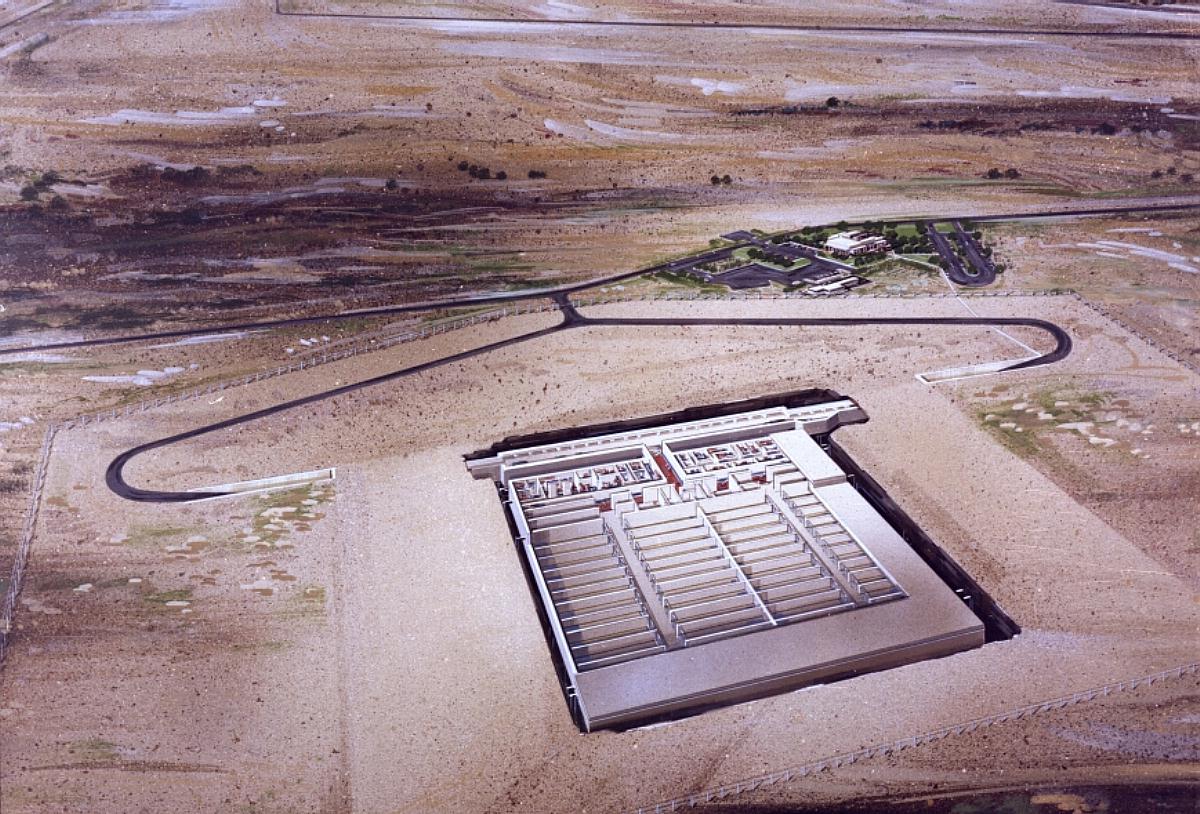Kirtland Underground Munitions Storage Complex
Birdseye

http://web.archive.org/web/200101160915im_/http://pdcunx.nwo.usace.army.mil/images/KUMSC_cutout.jpg






17 November 2012. Replace diagram of construction by US Army Corps of Engineers.
25 December 2005
One of the Birdseye Series to add 3-dimensions to the Eyeball Series.
Birdseyes from http://www.local.live.com
Only the south view birdseyes of the KUMSC complex appears to be available on live.local.com. These were discovered by panning from parts of Albuquerque which indicated birdseyes were available to those which showed KUMSC (directly over the complex there was no indication of birdseye availability, and none were found for north, east and west views).
From previous eyeballs of KUMSC:
The Kirtland Underground Munitions Storage Complex (KUMSC), located on Kirtland Air Force Base, Albuquerque, NM, is perhaps the single largest repository of nuclear weapons in the US if not the world.
Kirtland Air Force Base: http://www.kirtland.af.mil/
From the report Taking Stock: Worldwide Nuclear Deployments 1998, by William M. Arkin, Robert S. Norris and Joshua Handler, published in March 1998 by the Natural Resources Defence Council.
http://www.nrdc.org/nuclear/tkstock/p53-94.pdfNEW MEXICO
Rank: No. 1
Nuclear Warheads: 2450
Kirtland
AIR FORCE BASEBECAUSE OF A BACKLOG OF WARHEADS awaiting dismantlement at the DOE’s Pantex facility near Amarillo, TX, the Kirtland Underground Munitions Storage Complex (KUMSC) at Kirtland AFB, Albuquerque, New Mexico has emerged as number one in U.S. nuclear warheads deployed in a single location, a rise from 2nd place in 1992 and 11th place in 1985.
Kirtland AFB serves as one of two main Air Force nuclear weapons general depots in the United States (the other is at Nellis AFB in Nevada). And because of its 300 mile proximity to Pantex, Kirtland serves as a transshipment base and storage point augmenting the disassembly facility. Nuclear weapons are stored in the newly built, partially underground KUMSC facility, managed by the 898th Munitions Squadron of the 377th Air Base Wing (ABW), a unit of the Air Force Materiel Command. The 377th Air Base Wing received excellent and outstanding ratings in its 1994 NSI. They had another NSI on June 21-30, 1997. The 898th MUNS is scheduled to receive an NSI on September 28, 1998.
In 1945, nuclear weapons first came to the Sandia Base, and a special Manhattan District Military Police unit was established to guard the bombs as they were brought down from the Los Alamos laboratory for practice and operational loading on specially modified B-29 bombers. Nuclear warheads came for permanent storage in 1949, when the Manzano Base Weapons Storage Area ("Site Able"), a 2880 acre facility constructed amid a small range of foothills in the Manzano mountains near the southeast end of the base, was opened.
Initially the Army was responsible for Manzano, but in early 1952, the Air Force 1094th Special Reporting Group was established and took control of the base. The 1094th went through a variety of redesignations over the years, until 1 April 1994, when the current 898th Munitions Squadron was established. The 56-acre KUMSC was completed in 1994, consolidating warhead storage in a new facility outside of Manzano mountain. KUMSC is located on the southeast side of the installation, approximately 3.5 miles east of the main base. Nuclear weapons moved by air in and out of KUMSC use the Albuquerque International Airport.
An earlier eyeball of KUMSC which shows a 2004 aerial photo full-size (reduced version below):
http://eyeball-series.org/kumsc2/kumsc2-eyeball.htm
|
 |
| Diagram of construction.
http://web.archive.org/web/200101160915im_/http://pdcunx.nwo.usace.army.mil/images/KUMSC_cutout.jpg
|
KUMSC in 2002. From:
http://seamless.usgs.gov (reduced).
 |
| KUMSC March 2004 From:
http://seamless.usgs.gov (reduced)
|
| Looking South. The underground storage is to the rear and right
of the buildings. One access ramp is shown.
|
| Looking South. A slightly different angle.
|
| Looking South. Showing the full complex except part of the enclosing
barrier at right. There is a shallow hump at the center.
|